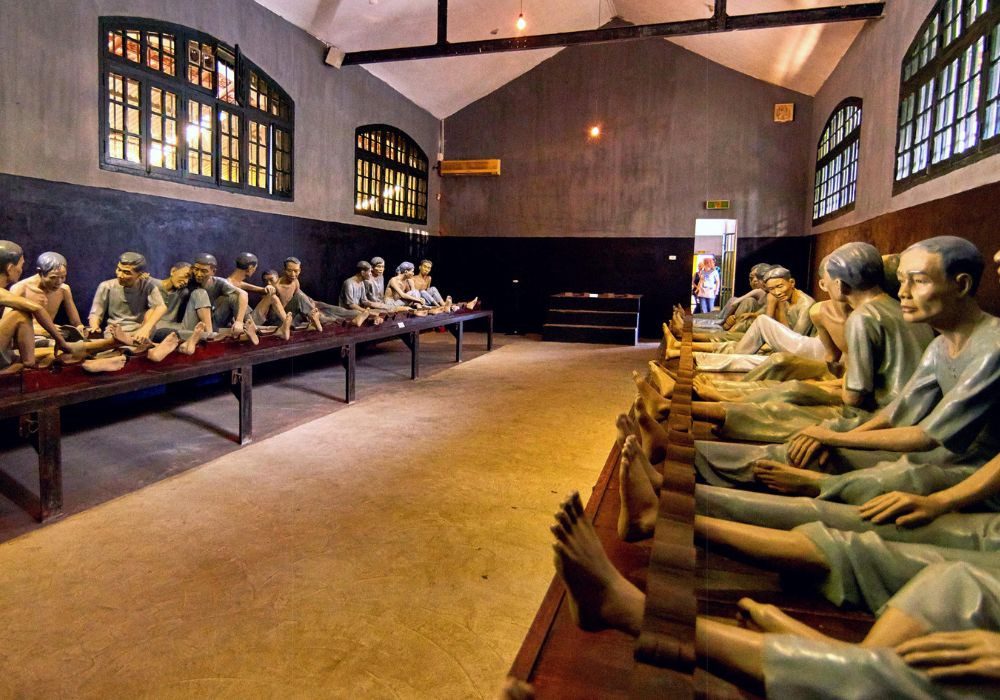Welcome to the captivating world of Hoa Lo Prison, a historical landmark that stands as a testament to Vietnam’s resilience and unwavering spirit. In this article, we will explore the rich history of it and delve into its significance as a symbol of resilience and resistance.
Hoa Lo Prison, commonly known as the “Hanoi Hilton,” holds a significant place in Vietnam’s history. Originally built by the French colonialists in the late 19th century, it was intended to confine political prisoners and revolutionaries who fought against French rule. However, Hoa Lo Prison’s story goes beyond its initial purpose, as it became a symbol of the indomitable spirit of the Vietnamese people.
Throughout its history, Hoa Lo Prison witnessed the unwavering determination of those incarcerated within its walls. Despite the oppressive conditions and hardships endured, the prisoners stood as a symbol of resilience and resistance against colonial rule. Their courage and defiance serve as a powerful reminder of Vietnam’s struggle for freedom and independence.

Historical Background of Hoa Lo prison
Hoa Lo Prison, located in the heart of Hanoi, has a rich and complex history that spans several tumultuous periods. Understanding its historical background is crucial to fully grasp its significance as a symbol of resilience.
Originally built by the French in the late 19th century, Hoa Lo Prison was intended to incarcerate Vietnamese political prisoners and revolutionaries who opposed French colonial rule. The prison’s name, “Hoa Lo,” translates to “fiery furnace,” reflecting the harsh and oppressive conditions that awaited its inmates.

During the French colonial era, Hoa Lo Prison was notorious for its brutal treatment of Vietnamese prisoners. Many were subjected to torture, inhumane living conditions, and forced labor. However, even in the face of such adversity, the spirit of resistance burned brightly within the hearts of those confined within its walls.
The prison’s history took another significant turn during the Vietnam War. Hoa Lo Prison was used to detain American prisoners of war, earning it the nickname “Hanoi Hilton” among American servicemen. While the conditions faced by these prisoners differed from those endured by Vietnamese inmates, it became another chapter in the prison’s storied past.
Life Inside the prison
The conditions and treatment of prisoners within the walls of Hoa Lo Prison were notoriously harsh and dehumanizing. In this section, we will delve into the realities faced by those incarcerated and shed light on the stories of resilience that emerged from within.
The cramped and overcrowded cells of Hoa Lo Prison offered little respite for its inmates. Prisoners were subjected to squalid living conditions, with limited access to basic necessities such as food, water, and sanitation facilities. Torture and physical abuse were common, aimed at breaking the spirits of political prisoners, activists, and resistance fighters who dared to challenge the oppressive regime.

However, even in the face of such dire circumstances, the prisoners of Hoa Lo Prison demonstrated remarkable strength and resilience. They found ways to communicate and support one another, often through clandestine methods such as tapping codes on the walls or passing messages during brief moments of interaction. These acts of solidarity helped to sustain the prisoners’ morale and keep their resistance alive.
Within the walls of Hoa Lo Prison, countless stories of bravery and determination unfolded. Political prisoners, activists, and resistance fighters who were incarcerated in the prison emerged as symbols of resilience, refusing to be silenced by their captors. Their unwavering commitment to their beliefs and their unwavering spirit of resistance became an indelible part of Hoa Lo Prison’s legacy.
A Historical landmark
Over the years, Hoa Lo Prison has undergone a significant transformation from a place of imprisonment and suffering to a historical landmark and museum. In this section, we will delve into the efforts made to preserve the prison and the exhibits that offer visitors a profound understanding of its historical significance.
Recognizing the historical value of Hoa Lo Prison, conservation and restoration efforts have been undertaken to preserve its original structures and atmosphere. The prison’s imposing gates, eerie cells, and grim corridors have been meticulously maintained to provide visitors with a glimpse into the past. Walking through the halls, one can’t help but feel a sense of somberness, as if the walls themselves hold the stories of those who suffered within them.

As a museum, Hoa Lo Prison offers a range of exhibits that shed light on its history and its significance in Vietnam’s struggle for independence. Through carefully curated displays, visitors can learn about the prison’s origins, its role during the French colonial era, and its use during the Vietnam War. Photographs, artifacts, and personal accounts provide a vivid depiction of the hardships endured by prisoners and the resilience they displayed in the face of adversity.
The exhibits also delve into the stories of notable individuals who were imprisoned within the walls of Hoa Lo Prison. From political activists to leaders of the Vietnamese independence movement, their experiences and sacrifices are showcased, paying homage to their unwavering spirit and their contributions to Vietnam’s struggle for freedom.
Today, Hoa Lo Prison stands as a testament to Vietnam’s resilience and a reminder of the nation’s tumultuous past. It serves as a place of reflection, inviting visitors to contemplate the struggles and sacrifices made by those who fought for a brighter future. By preserving its history and sharing its stories, Hoa Lo Prison ensures that the resilience and courage of its former inmates will never be forgotten.
In conclusion, Hoa Lo Prison holds a significant place in Vietnam’s history as a symbol of resilience and resistance. From its dark past to its present role as a historical landmark, the prison stands as a somber reminder of the struggles endured by those who fought for independence. By exploring the historical background, the stories of its prisoners, and its transformation into a museum, visitors can gain a deeper understanding of the prison’s significance in Vietnam’s journey towards freedom. A visit to Hoa Lo Prison is not only a chance to learn about the past but also an opportunity to reflect on the resilience of the human spirit in the face of adversity.
>>> See more: 10 things to do in Hanoi – Amazing traveling schedule you need to try!





